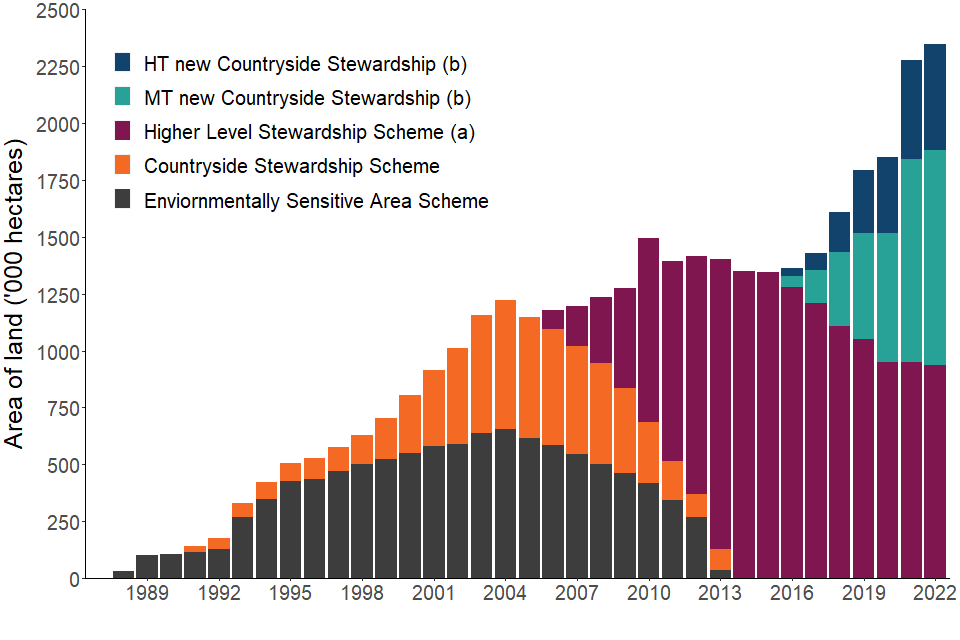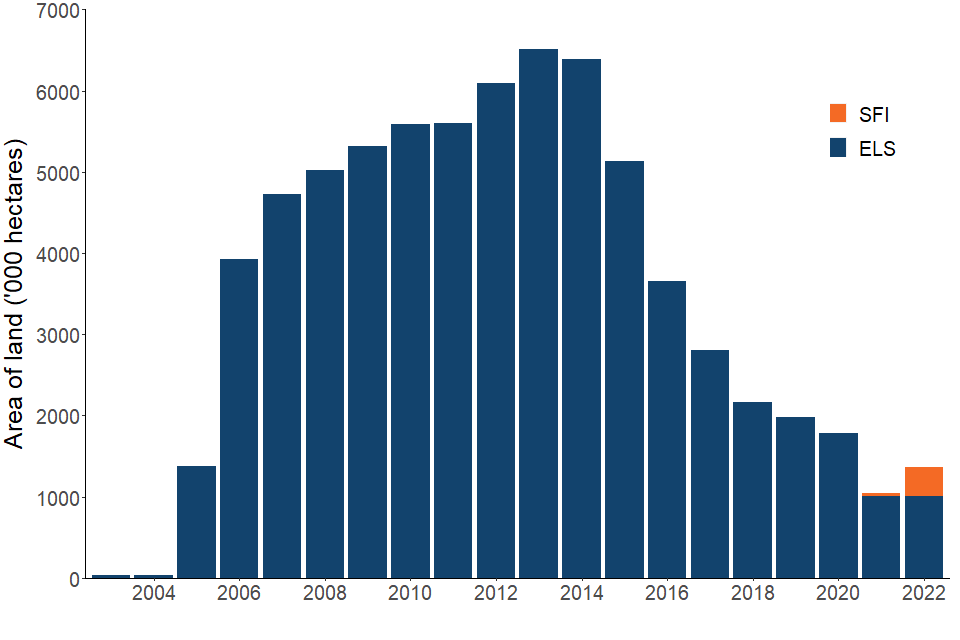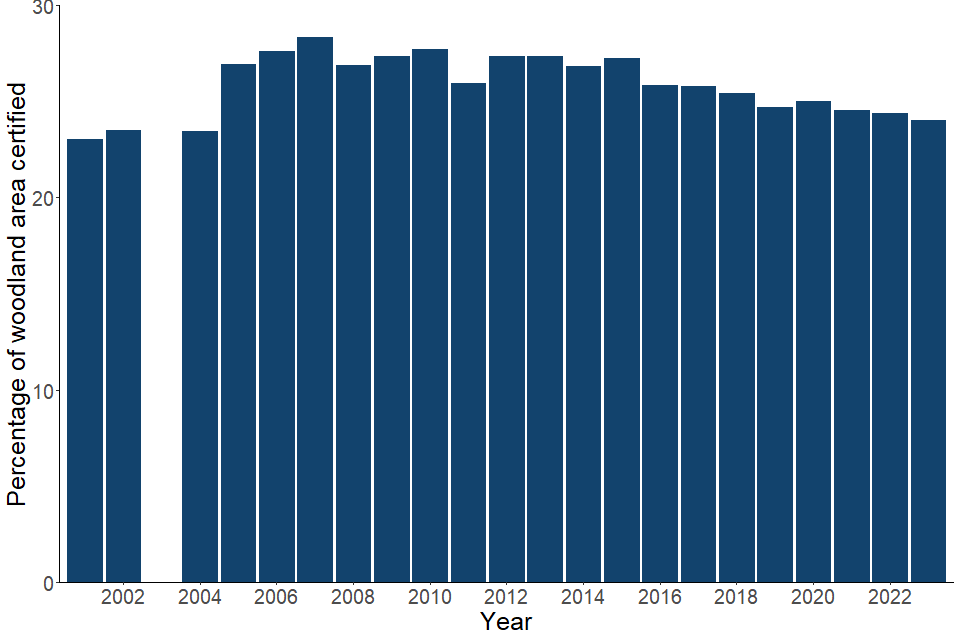22 Agri-environment and forestry
Updated 3 May 2024
Applies to England
Data last updated: November 2023
a. Area of land in agri-environment schemes
Latest data available - 2022
b. Area of forestry land under certified sustainable management schemes
Latest data available - 2023
Introduction
The first part of this indicator shows the area of land under agri-environment scheme agreements. Agri-environment schemes require land managers, including farmers, to implement environmentally beneficial management and to demonstrate good environmental practice on their land. The higher-level or targeted schemes promote environmental management aimed to: conserve wildlife; maintain and enhance landscape quality and character; protect the historic environment and natural resources; and promote public access and understanding of the countryside. The entry-level type schemes aim to encourage large numbers of land managers, to implement simple and effective environmental management on their land.
The second part of this indicator shows the percentage of the woodland area in England that is certified against agreed environmental standards. Woodland certification schemes promote good forest practice and are used to demonstrate that wood or wood products come from well-managed forests.
Type of indicator
Response indicator
Assessment of change
(a) Area of land under higher level or targeted agri-environment schemes:
- Long term (1987 to 2022): Improving
- Short term (2017 to 2022): Improving
- Latest year (2021 to 2022): Increased
(b) Percentage of woodland certified as sustainably managed (National Statistic):
- Long term (2001 to 2023): Little or no overall change
- Short term (2018 to 2023): Little or no overall change
- Latest year (2022 to 2023): Little or no overall change
Notes:
- Assessment of the individual measures is based on a 3-year average from the baseline, using the 3 earliest consecutive years available. See Assessing Indicators.
- An assessment of ELS (Entry Level Schemes) is not included as this scheme has closed. The new Countryside Stewardship scheme does not contain a similar strand for such an assessment to be continued in the future. As a result, it is appropriate to only provide an assessment of the higher level agri-environment schemes.
22a. Area of land in agri-environment schemes
Trend description for Figure 22.1
In 2022, the total area of land in all higher-level or targeted agri-environment agreements operating in England was 2.3 million hectares. Figure 22.1 shows the area of land under the previous higher-level, targeted schemes and the new Countryside Stewardship schemes. The expiring schemes include the HLS strand of ES and the ‘Classic’ schemes, namely Environmentally Sensitive Areas and the previous Countryside Stewardship Scheme. The chart shows that the area under targeted agri-environment schemes has gradually increased over time.
Figure 22.1: Area of land under expiring and new targeted agri-environment scheme agreements in England, 1987 to 2022

Source: Defra, Natural England
Download the data for Figure 22.1 in ods format
Notes about Figure 22.1
- Schemes are not directly comparable as they have different reporting requirements and different objectives.
- Systematic data collection started in 1992; areas from 1987 to 1991 are estimated. Uptake figures are the cumulative area assessed in December of year shown.
- (a)\ Higher Level Stewardship Scheme includes Freestanding HLS and HLS linked to ELS.
- (b)\ HT and MT new Countryside Stewardship schemes (HT, Higher-Tier; MT, Mid-Tier) – for 2016 only, co-located options are included. Taking account of co-location gives an actual area of 76,498 hectares.
Trend description for Figure 22.2
In 2022, the total area of farms with entry level agreements was 1.4 million hectares. Figure 22.2 shows the areas under the Sustainable Farming Incentive (SFI) and ELS. The area of land in ELS has shown a significant increase since pilot schemes were introduced in 2003/04, reaching around 6.5 million hectares in 2013. Existing agreements will continue to be honoured until they expire. Introduction of the SFI, including the SFI pilot which launched in 2021 and the full launch in 2022, is responsible for the overall increase in area covered by entry-level schemes from 2021 to 2022.
Figure 22.2: Area of land under expiring and new entry-level agri-environment schemes, 2003 to 2022

Source: Defra, Natural England
Download the data for Figure 22.2 in ods format
Notes about Figure 22.2
- Uptake figures are the cumulative area assessed in December of year shown.
- The area under ELS includes ELS, Organic Entry Level Stewardship (OELS), Uplands Entry Level Stewardship (UELS) from 2010, and HLS linked to ELS.
22b. Area of forestry land under certified sustainable management schemes (National Statistics)
Trend description for Figure 22.3
In March 2023, there were 319,000 hectares of certified woodland across England, representing 24% of the total woodland area. The proportion of woodland certified as sustainably managed has remained between 24% and 28% since 2005. Certification of woodlands promotes responsible forest management to safeguard forests’ natural heritage and protect threatened species. Since 2001, the percentage of woodland certified as sustainably managed in England has increased from 23% to 24% in 2023. The total area certified can change if new woodlands are certified, if existing certificate holders decide not to renew, or if there is a delay in renewal of an existing certificate.
Figure 22.3: Percentage of woodland in England certified as sustainably managed, 2001 to 2023

Download the data for Figure 22.3 in ods format
Notes about Figure 22.3
- This indicator is taken from the Forest Research National Statistics publication “Provisional Woodland Statistics”.
- All figures relate to data at 31 March, apart from 2001 (31 December) and 2002 (30 September), with regular data collection from 2004.
- Source: Forest Research.
Further information
Relevance
The indicator shows progress with commitments to improve the status of our wildlife and habitats. It is relevant to outcome 1 in Biodiversity 2020: A strategy for England’s wildlife and ecosystem services (see Annex A) and it is directly relevant to the following priority actions in the strategy:
Priority action 3.1: Improve the delivery of environmental outcomes from agricultural land management practices, whilst increasing food production.
Priority action 3.3: Bring a greater proportion of our existing woodlands into sustainable management and expand the area of woodland.
The indicator is also relevant to international goals and targets (see Annex B of the aforementioned publication).
The UK and England Biodiversity Indicators are currently being assessed alongside the Environment Improvement Plan Targets, and the new Kunming-Montreal Global Biodiveristy Framework Targets, when this work has been completed the references to Biodiversity 2020 and the Aichi Global Biodiversity Framework Targets will be updated.
Background
Agri-environment schemes
Agri-environment schemes require farmers and land managers to implement environmentally-beneficial management and demonstrate good environmental practice on their farm; they have existed since the mid-1980s.
In 1992, there were 175,000 hectares of land in England in Environmentally Sensitive Areas (ESA) and the previous Countryside Stewardship Scheme (CSS). These were higher level agreements or targeted schemes. At their peak, in 2004, there was around 1.2 million hectares in these schemes.
Between 2005 and the end of 2014, agri-environment activities were promoted through Environmental Stewardship (ES), replacing CSS and ESAs. This scheme had 2 strands; Entry Level Schemes (ELS) and Higher Level Schemes (HLS). Whilst ELS encouraged farmers and other land managers to undertake a broad range of activities to provide environmental benefits, HLS was a more targeted scheme. ELS agreements last for 5 years, whereas HLS agreements are 10 years in duration.
The ES scheme closed to new agreements in December 2014. Existing agreements continue to be honoured until they expire. Between the end of 2017 and the end of 2022, the number of ES agreements fell from 19,000 to 7,000. This decline was largely associated with ELS only agreements.
In 2015, a new agri-environment scheme, Countryside Stewardship, was introduced, replacing ES. The first agreements went live in 2016. This is a more targeted and competitive scheme. The strands of the scheme reported here are Mid-Tier and Higher-Tier. At the end of 2022, uptake of Countryside Stewardship consisted of around 18,000 agreements managing just over 1.4 million hectares of land. The areas quoted exclude co-located supplementary options. If these were included, the total area in Countryside Stewardship would be falsely inflated.
From 2021, the Sustainable Farming Incentive (SFI) was introduced and is an additional agri-environment scheme classed as entry-type. The SFI was piloted in 2021 and fully launched in 2022, to support the economy while achieving the goals of the 25 Year Environment Plan and commitment to net zero emissions by 2050. The scheme pays farmers to manage their land in an environmentally sustainable way. Introduction of the SFI is responsible for the latest year increase in overall land covered by entry-type schemes.
Fluctuations in areas of land under agri-environment agreements over time can occur as a result of the introduction of new schemes and the ending of previous scheme agreements. Existing agreements will continue to be honoured until they expire.
Overall agri-environment scheme coverage in England, December 2022
- Environmental Stewardship (ES) including ELS, ELS-HLS, HLS, ELS pilot and organic equivalents: Number of agreements: 7,300; Area: 1,141,000 hectares
- Sustainable Farming Incentive (SFI): Number of agreements: 2,200; Area: 358,000 hectares
- New Countryside Stewardship (mid-tier): Number of agreements: 14,700; Area: 948,000 hectares
- New Countryside Stewardship (higher-tier): Number of agreements: 2,900; Area: 466,000 hectares
Notes:
- This includes 739,424 hectares of Severely Disadvantaged Area.
- Source: Defra, Natural England.
Sustainable woodland management
The indicator shows the percentage of the woodland area in the UK that is certified against agreed environmental standards, derived from the areas reported on certificates and more detailed assessment of selected certificate holders.
Certification in the UK began in 1996, with data collation starting in 2001 and becoming a regular annual collation in 2004. All certified woodland in 2023 is certified under the Forest Stewardship Council (FSC) scheme or the Programme for the Endorsement of Forest Certification (PEFC) scheme, with many woodlands certified under both schemes. A breakdown for England of the area of woodland under certified management is given below. Certified woodland areas are often used as an indicator of sustainable management, however, it should be noted that woodland that is not certified may also be managed sustainably. New certificates may relate to existing woodland that was not previously certified or to newly planted areas.
In order for products made from timber to achieve certification, both forest management practices and the Chain of Custody, which tracks timber from forest to retail outlet, must be assessed.
Area of woodland owned and certified as sustainably managed in England, March 2023
- Forestry Commission: 214,000 hectares
- Private sector: 105,000 hectares
- Total woodland area certified: 319,000 hectares
Notes:
- Where possible, calculations have used the total woodland area certified, rather than the total land area certified.
- The total may not match the sum of figures in the rows above due to rounding.
- Source: Forest Research.
Web links for further information
- Forestry Commission: The UK Forestry Standard (UKFS)
- Forest Stewardship Council: FSC Certified Forest Certificate List
- Forest Research – Provisional Woodland Statistics: 2021 Edition: Forest Research Provisional Woodland Statistics
- Natural England: Environmental Stewardship; New Countryside Stewardship
- Programme for the Endorsement of Forest Certification (PEFC): International Forest Sustainability
